WORLD CLASS COACHING
40 Group and Tactical Defending Exercises
By Luca Bertolini
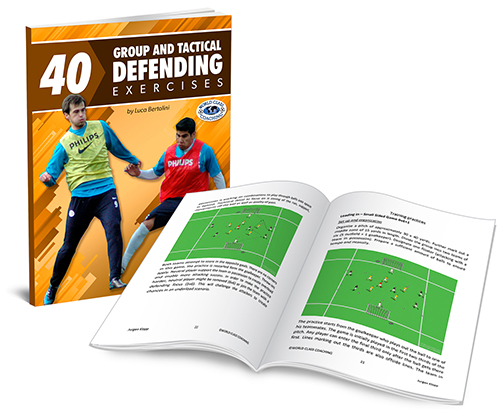
Table of Contents
PART TWO
Defending With and Against the 4-3-3
Defending With and Against the 4-2-3-1
1-4-3-3
Exercise 1: 3 + 3 v 4 (1)
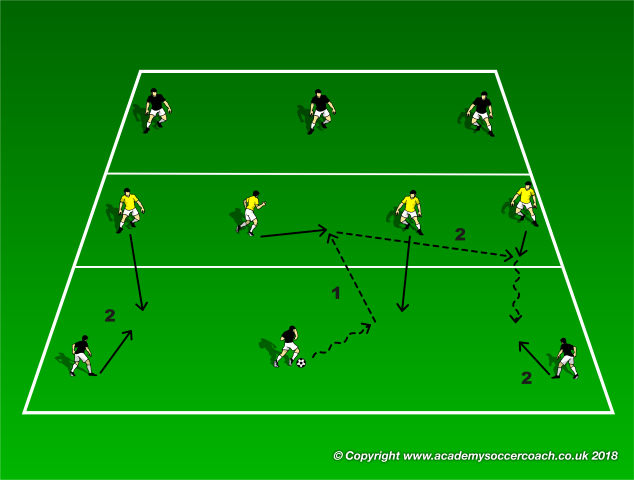
Set-up and Sequence: a rectangular area is divided into 3 parts and 10 players are involved in the exercise. 3 players of the black possession team are placed inside each outer area and 4 defenders are placed in the center one. One group of 3 is in possession and the ball must be moved toward the opposite zone.
The defenders must intercept the ball after closing the passing lanes, shifting across and moving forward and backward inside the center area, depending on the ball position (1).
Defense transition phase: if the defenders win the ball, they must dribble it inside the area where the ball was coming from. The 3 players who lost the ball, or who made a wrong pass, must counter the 4 yellow players, who are now in possession, to prevent the opponents from dribbling over the end line, by defending the depth in an outnumbered situation 3 v 4 (2).
Tactical key points: defend as block, maintain the players’ line distances, close the passing lane, depth defense.
Exercise 2: 3 + 3 v 4 (2)
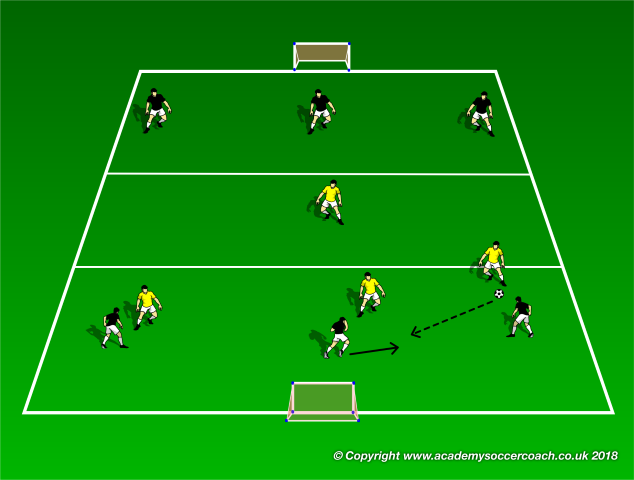
Set-up and Sequence: a rectangular area is divided into 3 parts and 10 players are involved in the exercise. 3 players of the black possession team are placed inside each outer area and 4 defenders are placed in the center one. One group of 3 is in possession and the ball must be moved toward the opposite zone.
3 defenders must press the possession group, moving forward inside the outer area where the ball is being played. The fourth defender must provide balance, staying placed inside the center area and intercepting any forward pass.
Defense transition phase: if the defenders win the ball, they must dribble over the end line. The 3 players who lost the ball, or who made a wrong pass, must counter the 3 yellow players who are now in possession to prevent them from dribbling, by counter pressing in a 3 v 3 situation.
Tactical key points: pressure, balance, close the passing lane, counter pressing.
Exercise 3: 3 + 3 v 4 (3)
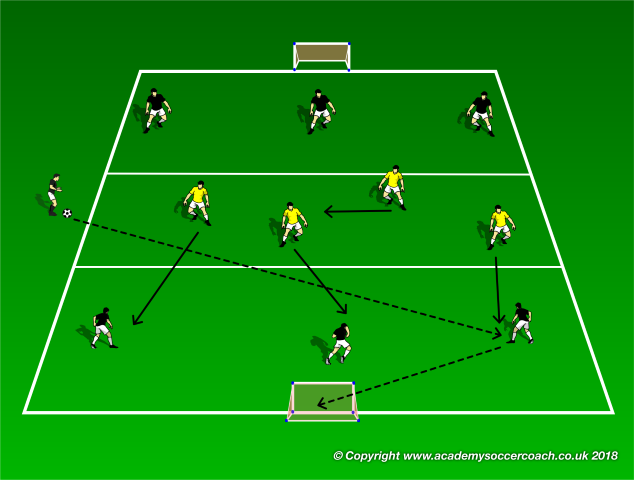
Set-up and Sequence: this exercise is a progression of the previous one. A rectangular area is divided into 3 parts and 10 players are involved in the exercise. 3 players of the black possession team are placed inside each outer area and 4 defenders are placed in the center one. 2 goals are added, as in the picture. The coach decides the first possession group of 3, by passing the ball inside their zones.
3 defenders must press the possession group, moving forward inside the outer area where the ball is being played. The fourth defender must provide balance staying placed inside the center area and intercepting any forward pass. They must avoid the passes toward the opposite area, where the other 3 forwards must score.
Defense transition phase: if the defenders win the ball, they must score in the mini goal of the area where the possession is recovered. The 3 players who lost the ball, or who made a wrong pass, must counter the 3 yellow players, who are now in possession, to prevent them from scoring, by counter pressing in a 3 v 3 situation.
Tactical key points: pressure, balance, close the passing lane, counter pressing.
Exercise 4: 3 + 3 v 4 (4)
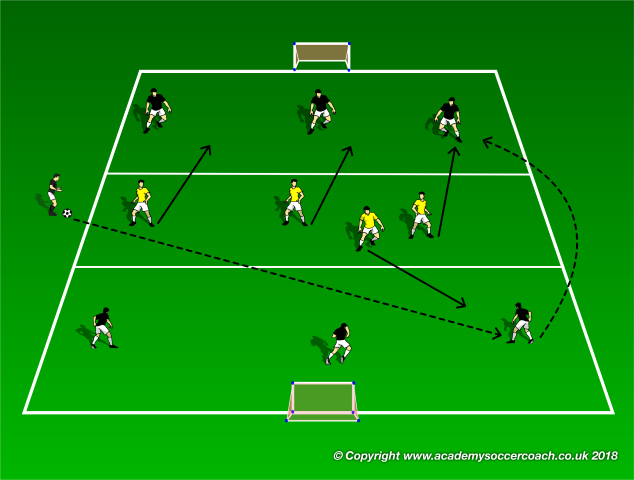
Set-up and Sequence: this exercise is another progression of the previous one. A rectangular area is divided into 3 parts and 10 players are involved in the exercise. 3 players of the black possession team are placed inside each outer area and 4 defenders are placed in the center one. 2 goals are added, as in the picture. The coach decides the first possession group of 3 by passing the ball inside the zone.
The defenders must save the depth, by moving backward inside the area where the ball is being played, after the first kick of the coach where the receiver passes the ball with a long one touch. The fourth defender must press the receiver to prevent him from passing the ball forward.
Defense transition phase: if the defenders win the ball, they can counter-attack to score in the mini goal of the opposite area. If the ball is lost during the first phase, the black players must counter-press the new possession team. If the ball is lost during the second phase, the 3 lower players must save the goal space against 4 yellow players and the 3 further one must retreat to shape a 6 v 4 duel, creating defensive numerical advantage to recover the possession.
Tactical key points: defend the depth, counter pressing, retreat to create defensive numerical advantage, patience.
Exercise 5: 3 + 3 v 4 + gk (1)
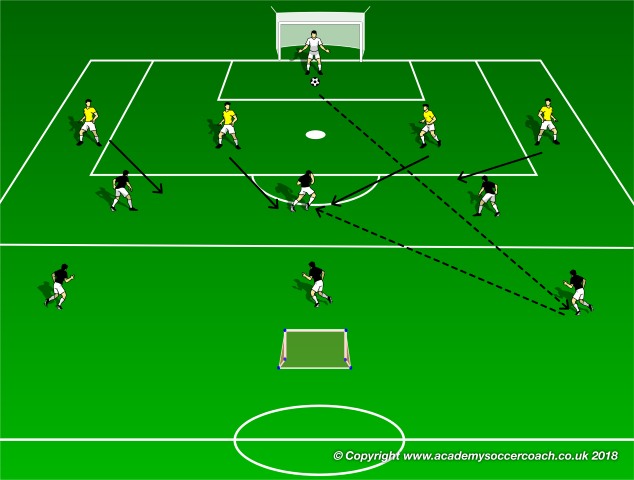
Set-up and Sequence: Place 10 field players and 1 goalkeeper inside a third of a regular field that is divided into 2 parts. 4 defenders and the goalkeeper are placed inside the finishing half, as well as 3 forwards; 3 more forwards are placed inside the lower half. The goalkeeper has the possession.
As the goalkeeper kicks the ball toward the one of the further attackers, the 4 defenders must put pressure against the 3 nearest black opponents, condensing the center and saving the goal space, preventing them from receiving, turning and finishing.
Defense transition phase: if the defenders win the ball, they can counter-attack to score in the mini goal of the opposite area. The 3 lower players must save the goal space against the 4 yellow players and the 3 attackers must retreat to shape a 6 v 4 duel, creating defensive numerical advantage to recover the possession.
Tactical key points: condense the center, pressure to prevent the opposition progression of the possession phase, retreat to create defensive numerical advantage, save the depth.
Exercise 6: 3 + 3 v 4 + gk (2)
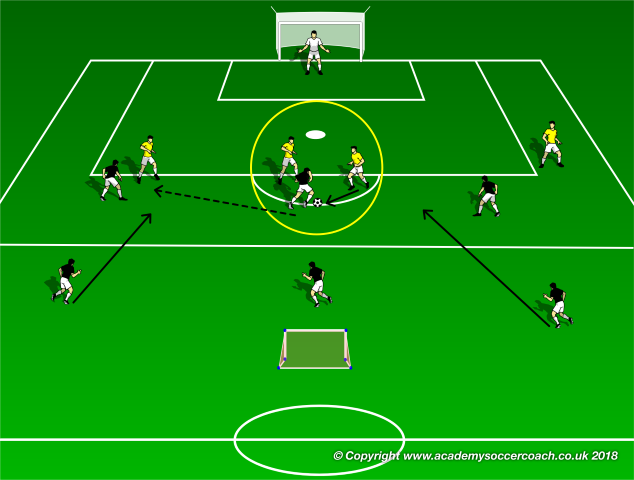
Set-up and Sequence: this exercise is a variation of the previous one. 10 field players and 1 goalkeeper are placed inside a third of a regular field, that is divided into 2 parts. 4 defenders and the goalkeeper are placed inside the finishing half, as well as 3 forwards; 3 more forwards are placed inside the lower half. The goalkeeper has the possession. As the goalkeeper kicks the ball toward one of the attackers, the 4 defenders must put pressure against the 3 nearest black opponents, condensing the center and saving the goal space, preventing them from receiving and finishing, and recovering the possession within 6". If they can't, 2 black players can run inside to play a 5 v 4 duel, creating a numerical disadvantage for the defenders, who must now save the goal space and the depth.
Defense transition phase: if the defenders win the ball within 6", they can counter-attack to score in the mini goal of the opposite area, playing 4 v 3. The 3 lower players must save the mini goal space against the 4 yellow players; the 3 attackers can't retreat. If the defenders are able to recover the possession even if they are outnumbered, they can counter attack and the 3 forwards must retreat to draw the number of players (4 v 4 duel).
Tactical key points: pressure to recover the possession as soon as possible, stay balanced, save the goal space when outnumbered, retreat to support the defense phase, save the depth.
Exercise 7: 3 + 3 and gk v 7 + gk (1)
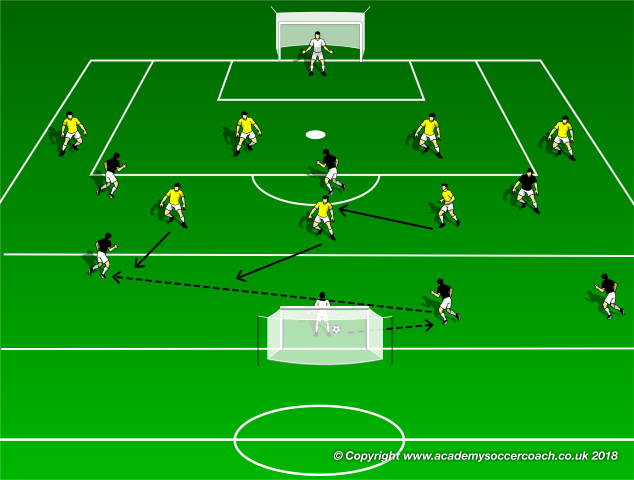
Set-up and Sequence: 13 field players and 2 goalkeepers are placed inside a third of a regular field that is divided into 2 parts (a smaller building up and pressure one and a bigger attacking/defending one). 4 defenders, 3 midfielders and the goalkeeper of the team without possession are placed inside the bigger area, as well as 3 forwards; 3 more forwards and the second goalkeeper are placed inside the lower half.
The goalkeeper of the black team has the possession. As the goalkeeper passes the ball, 2 midfielders of the defending team must run inside to put pressure against the 3 black opponents, forcing their building up phase wide and preventing them from playing out. The third yellow midfielder must provide balance at their back. The back 4 must mark the forward and press to prevent them from receiving in a 4 v 3 situation.
Defense transition phase: if the midfielders win the ball, they can counter-attack to score as quickly as possible together with the third teammate. The 3 lower players must close the goal space and the 3 attackers must retreat to shape a 6 v 3 duel, creating defensive numerical advantage to recover the possession.
If the defenders recover the possession a 7 v 6 duel is created; the new defending team must be balanced and shape a back 4 line by retreating one of the attackers who is not pressing the yellow opponents.
Tactical key points: force the opposition possession outside, provide balance, mark the opponents to prevent them from receiving, organize a back 4 line to save the depth.
Exercise 8: 3 + 3 and gk v 7 + gk (2)
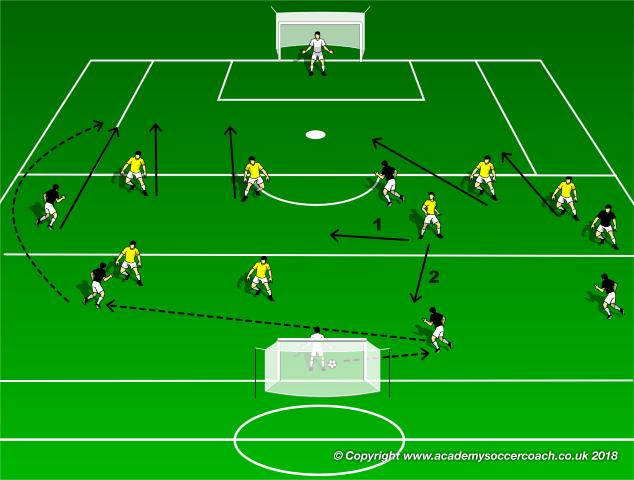
Set-up and Sequence: this exercise is a progression of the previous one, where 13 field players and 2 goalkeepers are placed inside a third of a regular field, that is divided into 3 parts (the outer 2 areas as long as the penalty area and the center one that is smaller than the other 2). 4 defenders and 1 balance midfielder of the team without possession are placed inside the middle area, as well as 3 forwards; 3 more black players and 2 yellows are placed inside the lower half. The last third of the field is empty at the beginning.
The goalkeeper of the black team has the possession and as he passes the ball, 2 midfielders of the defending team must put pressure against the 3 black opponents, forcing their building up phase outside and preventing them from playing long passes toward the final finishing third of the field. The third yellow midfielder must decide whether to provide balance at their back (1) or to help the pressure during the opposition building up phase. The back 4 must retreat toward the defensive third to save the goal space and to avoid any shot attempt.
Defense transition phase: if the midfielders win the ball, they can counter-attack to score as quickly as possible, together with the third teammate. The 3 lower players must close the goal space and the 3 attackers must retreat to shape a 6 v 3 duel, creating defensive numerical advantage to recover the possession.
If the defenders recover the possession a 7 v 6 duel is created; the new defending team must be balanced and shape a back 4 line by retreating one of the attackers who is not pressing the yellow opponents
Tactical key points: force the opposition possession outside, pressure or provide balance, retreat to defend the depth, organize a back 4 line to save the depth.
1-4-2-3-1
Exercise 9: 6 v 6
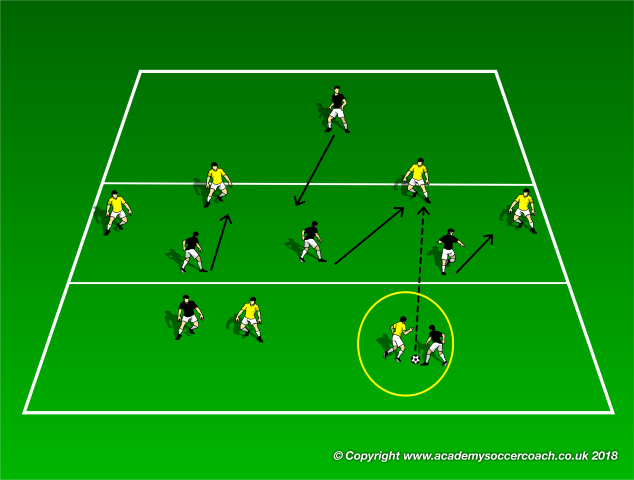
Set-up and Sequence: a rectangular area is divided into 3 parts and 12 players are involved in the exercise. 4 defenders are placed in the center zone, playing against 3 black forwards. 2 black and 2 yellow players are placed inside the lower area and the last black forward stays inside the third upper zone. The 2 yellow players inside the lower area must put pressure to prevent the opponents from building up and playing toward the middle area. The objectives and the sequence are the same as the previous exercise, but if the defenders win the ball.
Defense transition phase: if the 2 yellow players win the ball, they must pass backward before attacking the end line of the opposition. The players of the team who lost the possession, must stay balanced inside the center third against the opposition, waiting for the forward who is retreating to draw the number of players (4 v 4). The same sequence must be carried out if the 4 defenders win the ball.
Tactical key points: force the opposition possession backward, pressure and balance while waiting for support.
Exercise 10: 6 v 4
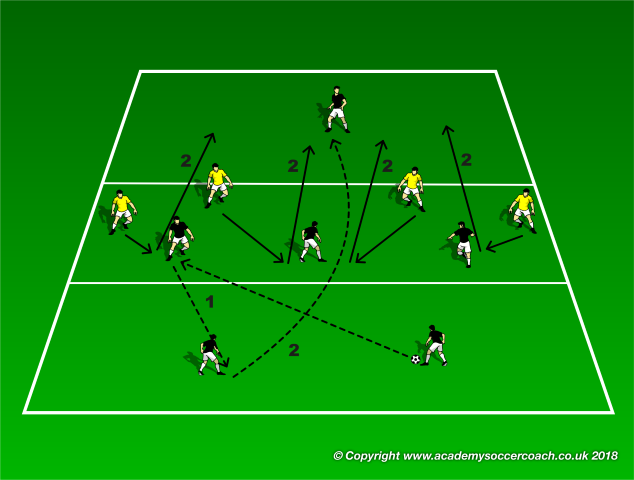
Set-up and Sequence: a rectangular area is divided into 3 parts and 10 players are involved in the exercise. 4 defenders are placed in the center zone, playing against 3 black forwards. 2 black players are placed inside the lower area and the last one is inside the third upper zone.
The defenders must put pressure, shifting across and moving forward and backward inside the center area, depending on the ball position, to prevent the forwards from receiving and playing backward (1).
If the 2 free midfielders can receive a return pass, they must try play a long ball toward the opposite outer area; the defenders must then retreat to save the depth and clear or win the ball.
Defense transition phase: if the defenders win the ball during the pressure phase, then they dribble it inside the area where the ball was coming from to overcome the end line.
The 2 lower black players must counter the 4 yellows, who are now in possession, waiting for their teammate retreating from the center area, to prevent the opponents from dribbling over the end line, by defending the depth in a 5 v 4 overload situation.
If the yellow team is not able to dribble over the end line within 6", then also the black forward can retreat to press and to win the possession too.
Tactical key points: defend as block, maintain the players’ line distances, close the passing lane, depth defense.
Exercise 11: 6 v 6 + gks (1)
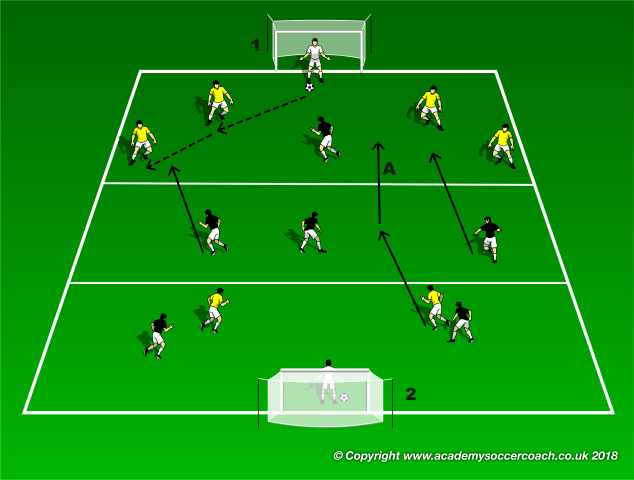
Set-up and Sequence: a rectangular area is divided into 3 parts and 12 field players are involved in the exercise. 2 goalkeepers in possession of a ball defend a numbered goal each (1-2). 4 defenders are placed inside their first third against 1 black forward. 3 black players are freely placed inside the middle third and 2 black and 2 yellow players are placed inside the lower area.
The coach decides the goalkeeper who must start the exercise (1 in the picture); as the first yellow player receives, 2 midfielders must run inside the building up area to put pressure and to close the passing lanes toward the advanced yellow players. 1 yellow player should drop back inside the middle third to play a 1 v 1 duel against the last black opponent after the first pass of the goalkeeper; the black player must mark him on inside there.
If the dropping back player decides to help the building up phase (A - 5+gk v 3), the black players must decide if to press there again, or if to retreat to defend the first third, helping the teammates who are involved in a 2 v 2 + gk duel.
Defense transition phase: if the defending team wins the ball, then the yellow players must counter press the opposition possession phase, both inside the final and in the middle third.
Tactical key points: force the opposition possession, pressure and balance while waiting for support.
Exercise 12: 6 v 6 + gks (2)
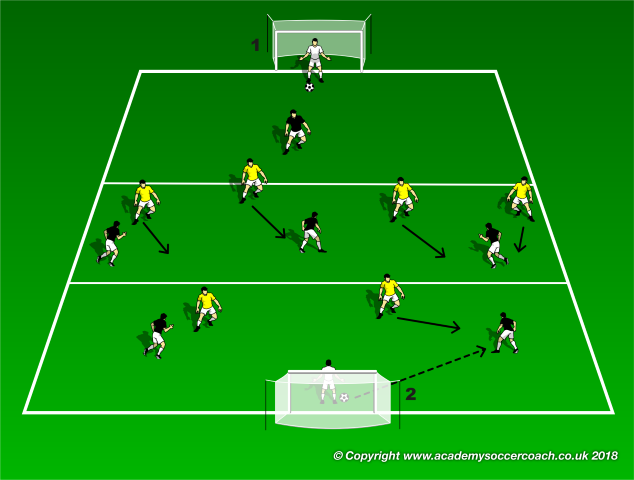
Set-up and Sequence: this exercise is a progression of the previous one (2). If the coach decides to ask the black goalkeeper to start the sequence, the yellow defenders must move forward inside the middle third as a block, closing the space and trying to leave the forward offside. If the black team is able to play out, then the defenders must retreat toward their first third to cover the depth.
Defense transition phase: if the defending team wins the ball, then the black players must manage an outnumbered situation 5 v 6, both inside the final third and in the middle third. If they are able to counter the opponents for more than 6", the sixth black player can retreat to equalize the duel.
Tactical key points: force the opposition possession, retreat to defend the depth, pressure and balance while waiting for support.
Exercise 13: 4 v 4 + gk
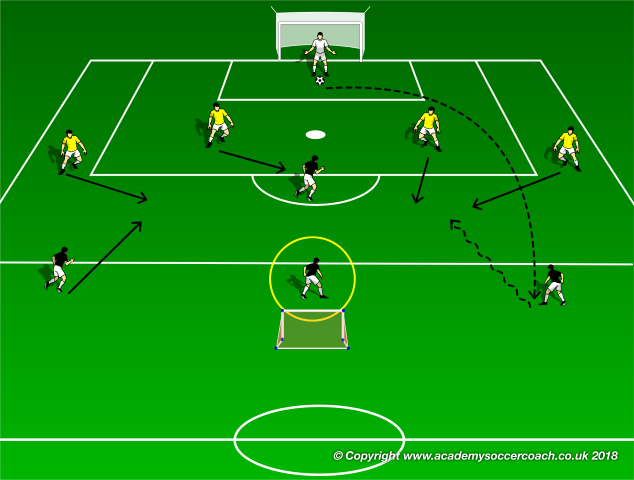
Set-up and Sequence: 8 field players and a goalkeeper are placed inside a third of a regular field that is divided into 2 parts. 4 defenders and the goalkeeper are placed inside the finishing half, as well as 1 forward; 3 more free forwards are placed inside the lower half. 1 regular goal and 1 mini goal are placed along the end lines. The goalkeeper has the possession.
As the goalkeeper kicks the ball toward the one of the attackers, the 4 defenders must put pressure against 3 opponents (1 inside and 2 incoming), to leave them out of the penalty area and making them facing their own goal. 1 black player must provide balance inside the lower area. The center defenders are asked to anticipate the center forward.
Defense transition phase: if the defenders win the ball, they can counter-attack to score in the mini goal of the opposite area. The lower player must save the mini goal space against the 4 yellow players and the 3 attackers must retreat to shape a 4 v 4 duel, to organize a back 4 defense line as soon as possible.
Tactical key points: pressure to prevent the progression of the opposition’s possession phase, retreat to organize a defense line, save the depth.
Exercise 14: 6 v 4 + gk
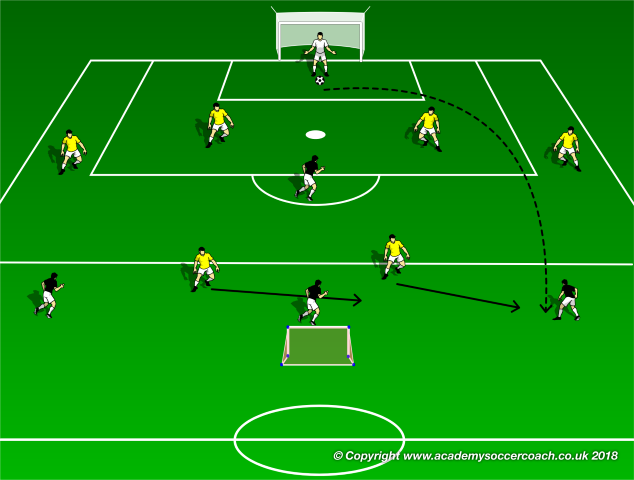
Set-up and Sequence: 10 field players and a goalkeeper are placed inside a third of a regular field that is divided into 2 parts. 4 defenders and the goalkeeper are placed inside the finishing half, as well as 1 forwards; 3 more free attackers and 2 defenders are placed inside the lower half. 1 regular goal and 1 mini goal are placed along the end lines. The goalkeeper has the possession.
As the goalkeeper kicks the ball toward one of the attackers, 2 yellow players must put pressure against 3 opponents to force their possession phase toward the sidelines or making them face their own goal.
The black forward can decide whether to drop back or not in this first phase (the defense line will move as a block). The center defenders are asked to anticipate the center forward or to counter 2 of the 3 other players. The center forward shall be double marked by the center backs or by a center back and a full back.
Defense transition phase: if the 2 first defenders win the ball, they can counter-attack to score in the mini goal of the opposite area. The lower players must counter press, being in numerical advantage 3 v 2. If the 4 black yellow defenders win the ball, then they can counter attack and the 3 attackers must retreat to be a support for the teammates and to limit the defensive numerical advantage 4 v 6.
Tactical key points: pressure to prevent the progression of the opposition possession phase, defend forward to recover the possession, retreat to cover the space and to organize a defense line, save the depth.
Exercise 15: 4 v 4 + gk
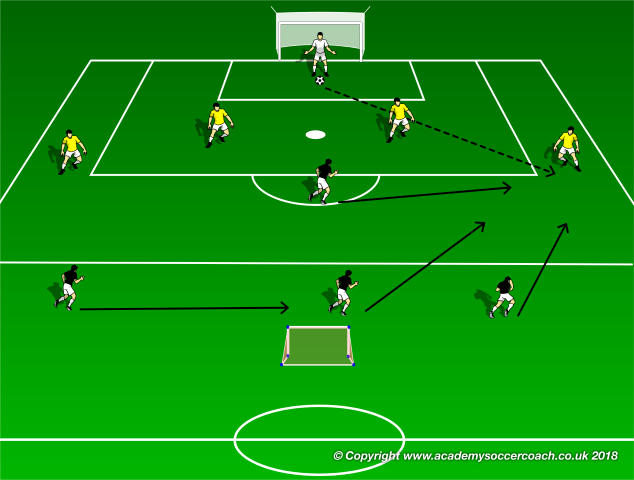
Set-up and Sequence: 8 field players and a goalkeeper are placed inside a third of a regular field that is divided into 2 parts. 4 defenders and the goalkeeper are placed inside the finishing half, as well as 1 forward; 3 more free forwards are placed inside the lower half. 1 regular goal and 1 mini goal are placed along the end line of one side and 15 yards over the other one. The goalkeeper has the possession.
As the goalkeeper kicks the ball toward one of the fullbacks to build up, 3 of the 4 black players must put pressure creating a strong side (1 forward and 2 teammates who are coming from the other half), to force the direction of possession toward the sidelines and making them face their own goal. 1 black player must provide balance inside the lower area, shifting across from the opposite weak side.
If the yellow players are able to play out, reaching the finishing half, the black players must retreat to support the balance teammate and to close the goal space.
Defense transition phase: if the team without the possession wins the ball, a counter-attack can be carried out through a 4 v 4 duel. The yellow players can retreat to cover the space or to organize a counter pressing action, if the ball can be recovered quickly.
Tactical key points: create a strong side through pressure, retreat to organize the defense line, save the depth, counter pressing.
Exercise 16: 6 + gk v 4
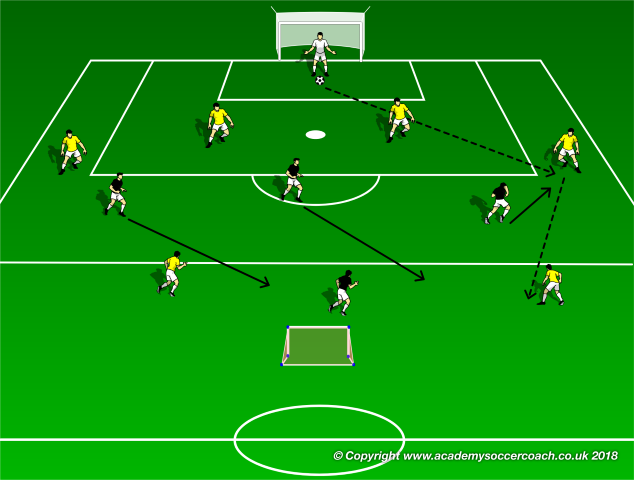
Set-up and Sequence: 10 field players and a goalkeeper are placed inside a third of a regular field that is divided into 2 parts. 4 defenders and the goalkeeper are placed inside the finishing half, as well as 3 forwards; 1 more free forward and 2 players of the yellow team are placed inside the lower half. 1 regular goal and 1 mini goal are placed along the end line of one side and 15 yards over the other one. The goalkeeper has the possession.
As the goalkeeper kicks the ball toward one of the fullbacks to build up, 1 black player must put pressure trying to force the direction toward the sideline. 2 black players must try to create a defensive strong side in the lower area, retreating back before a yellow player can receive the second pass.
This way the opponent in possession is outnumbered and the passing lane toward the other teammate is supposed to be closed.
Defense transition phase: if the first black player wins the ball, his team can counter-attack to score in the main goal of the opposite area (all the black players are involved). The yellow players must counter press, defending by running forward to avoid any finishing attempt. If the possession is recovered inside the defense third, the 2 yellow players can retreat to create a defensive numerical advantage 6 v 4.
Tactical key points: create a defensive strong side, defend forward to prevent the opposition's finishing attempt, retreat to create defensive numerical advantage.
Exercise 17: 5 + 2 v 5 and gks
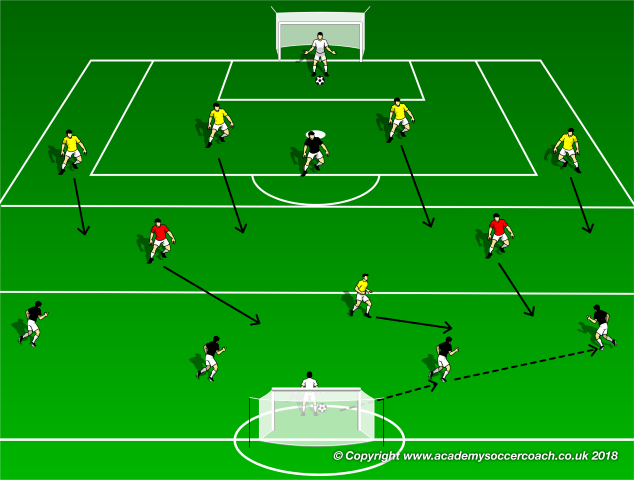
Set-up and Sequence: 12 field players and 2 goalkeepers are placed inside a half of a regular field that is divided into 3 parts (the center one is smaller than the other two). Each team is shaped with 4 defenders (inside the first third) and 1 forward (inside the final third); 2 more red free players are placed inside the center area, as support for the defending team.
The goalkeeper of the black team has the possession and he starts the sequence, passing the ball toward a fullback to build up; the defending team must put pressure against the 4 black opponents, condensing the ball area thanks to the free players and forcing the opposition building up phase out, to prevent them from playing long passes toward the final finishing third of the field. The back 4 must move forward toward the middle area to leave the forward offside and to close the deepest passing lanes.
Defense transition phase: if the ball is recovered during the first pressure phase, then a 3 v 4 counter attack can be carried out; as the defenders have numerical advantage till the opposition reaches the middle area, they can try to counter press to win the ball back again. If the possession is won inside the middle third, the move must start from the goalkeeper of the new possession team, who must build up; the team who lost the possession must now press the opposition inside the first third and move forward the back line of 4.
Variation: the same sequence can be played on the other side, as the yellow goalkeeper starts the sequence, following the indications of the coach or alternating the sequences.
Tactical key points: condense the ball area, counter pressing and defend forward the covered balls.
Exercise 18: 8 v 8 + 2 and gks
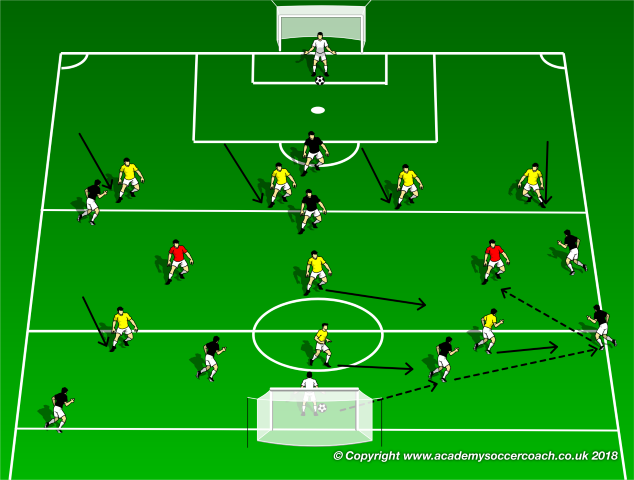
Set-up and Sequence: 18 field players and 2 goalkeepers are placed inside 3/4 of a regular field that is divided into 3 parts (the building up area of the attacking black team is smaller than the other two). Each team is shaped with 4 defenders (inside the first third), 3 advanced midfielders (free to move inside the middle or the final third) and 1 center forward inside the final third; 2 more red free players are placed inside the middle third, as support for the possession team. The goalkeepers have the possession.
The goalkeeper of the black team starts the sequence, passing the ball to a fullback to build up inside the smaller first third; the defending team (3 forwards) must put pressure against the 4 black opponents, condensing the ball area and forcing the opposition building up phase outside to prevent them from playing inside the final finishing third of the field and toward the free players.
The balance midfielder (who is outnumbered 1 v 2) must counter the potential receiver, preventing him from turning and forcing the direction of play backward; if possible he should mark him on, being placed in a useful position to close the passing lane toward the second one. The back four must move forward toward the middle area to leave the forward offside and to close the deep passing lanes, but staying balanced and as a unique block to cover the penalty area and the goal space.
Defense transition phases:
1) If the defenders recover the possession inside the first third, a 3 v 4 counter-attack can be played; the black players, who lost the possession, must counter press immediately being in numerical advantage to close the goal space and to force the direction of play backward.
2) If the defending team recovers the possession inside the middle third, then the free players become active as support for the new team in possession; a 6 v 4 counter-attack is then created. The black defenders must then retreat to cover the goal space and the deep passing lanes because of the outnumbered situation.
3) If the possession is recovered inside the first third, a 10 v 8 sequence starts; the forward and the advanced midfielders of the new defending team must retreat to counter the possession phase of the opposition, and the back 4 must decide if to cover the depth or if to stay placed high, even if outnumbered, to prevent deep passes.
Variation: the same sequence can be played on the other side, as the yellow goalkeeper starts the sequence; the building up area and the pressure area are then bigger than the opposite one. The pressure phase of the defending team must be stronger in the middle and final third. They can decide to let the opposition building up and then pressing as the ball is played inside the middle third, asking the advanced players to retreat as the sequence starts.
Tactical key points: condense the ball area, counter pressing, retreat if outnumbered, overload the center space if outnumbered.


